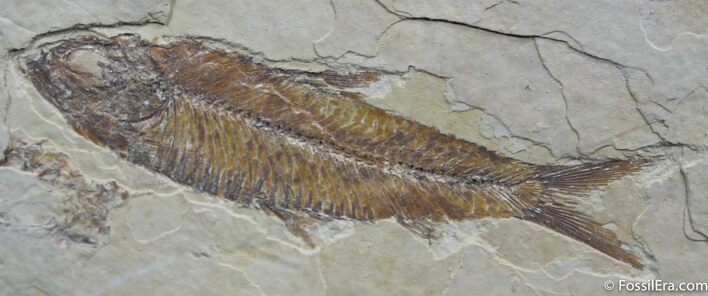This Specimen has been sold.
Google+ Contest Prize: Knightia Fossil Fish
Win This Fossil Fish!
To help celebrate #FossilFriday we are running a series of fossil giveaways on our various social media accounts (Facebook, Twitter, Google+ and Pinterest). This is the prize for today's Google+ contest that will run for 24 hours from noon (PST) on Friday.
To enter go to our Google+ Page, find the contest post, +1 it and leave a comment. After the contest ends we will randomly select a winner and contact them via Google+.
Be sure to +1 our page if you haven't yet as we will be regularly running contests, special offers as well as providing updates on new listings.
Other #FossilFriday Contests
We're running similar contests on Twitter, Facebook and Pinterest concurrently so check them out also.
Trilobite For Twitter
Megalodon Tooth For Facebook
Fossil Ammonite For Pinterest
Now About The Fossil
To help celebrate #FossilFriday we are running a series of fossil giveaways on our various social media accounts (Facebook, Twitter, Google+ and Pinterest). This is the prize for today's Google+ contest that will run for 24 hours from noon (PST) on Friday.
To enter go to our Google+ Page, find the contest post, +1 it and leave a comment. After the contest ends we will randomly select a winner and contact them via Google+.
Be sure to +1 our page if you haven't yet as we will be regularly running contests, special offers as well as providing updates on new listings.
Other #FossilFriday Contests
We're running similar contests on Twitter, Facebook and Pinterest concurrently so check them out also.
Now About The Fossil
About Knightia
Knightia is an extinct genus of small, schooling, ray-finned fish related to modern herrings and sardines. Abundant in the warm freshwater lakes of the Eocene Green River Formation, they fed on insects, plankton, and tiny fish, while serving as prey for nearly every larger predator in the ecosystem. The most common species, Knightia eocena, reached about 15 cm in length and is celebrated today as the state fossil of Wyoming.
These streamlined fish are recognized by their heavy scales, small conical teeth, and rows of dorsal and ventral scutes along the body. Their fossils are among the most iconic from the Green River Formation—an exceptional 48-million-year-old lake deposit in Wyoming, Colorado, and Utah known for preserving a remarkably detailed snapshot of ancient life in a warm, lake-rich Eocene landscape.
Knightia is an extinct genus of small, schooling, ray-finned fish related to modern herrings and sardines. Abundant in the warm freshwater lakes of the Eocene Green River Formation, they fed on insects, plankton, and tiny fish, while serving as prey for nearly every larger predator in the ecosystem. The most common species, Knightia eocena, reached about 15 cm in length and is celebrated today as the state fossil of Wyoming.
These streamlined fish are recognized by their heavy scales, small conical teeth, and rows of dorsal and ventral scutes along the body. Their fossils are among the most iconic from the Green River Formation—an exceptional 48-million-year-old lake deposit in Wyoming, Colorado, and Utah known for preserving a remarkably detailed snapshot of ancient life in a warm, lake-rich Eocene landscape.
SPECIES
Knightia eocaena
LOCATION
Kemmerer, Wyoming
FORMATION
Green River Formation
SIZE
Largest is 2.8"
CATEGORY
SUB CATEGORY
ITEM
#777
We guarantee the authenticity of all of our specimens.
 Reviews
Reviews












